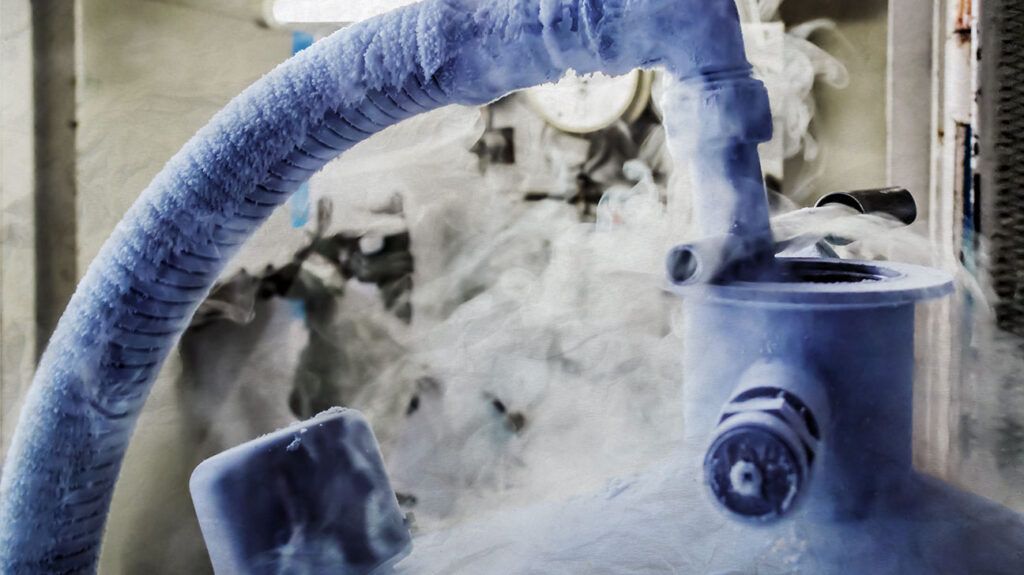The side effects of cryotherapy on the cervix include pain, discharge, and risk of infection.
Cryotherapy is a therapeutic technique that uses sub-zero temperatures to treat various medical and cosmetic conditions. Healthcare professionals typically use liquid nitrogen or other freezing agents to reach extremely low temperatures to target and remove abnormal skin lesions.
When applied to the cervix, cryotherapy helps treat precancerous lesions caused by human papillomavirus (HPV). This noninvasive procedure involves freezing the affected tissue, causing the abnormal cells to die off and allowing healthy cells to grow.
The procedure is widely regarded as safe and effective, although some side effects of cryotherapy on the cervix include cramping, watery discharge, or mild bleeding post-treatment.
This article covers the benefits and side effects of cryotherapy on the cervix and when a person should contact a doctor.

Cryotherapy, although minimally invasive, can still result in various side effects, some of which may require careful monitoring. Common side effects of cryotherapy on the cervix include:
- Watery discharge: According to the United Kingdom’s National Health Service (NHS), this common side effect can last up to 4 weeks. It may contain blood as the frozen tissue begins to shed and heal. It is part of the body’s natural healing process.
- Cramping and discomfort: Similar to menstrual cramps, individuals may feel mild to moderate pelvic pain during and after the procedure. Over-the-counter pain relievers, such as ibuprofen, can help ease discomfort.
- Risk of infection: There is a slight risk of developing an infection that may require antibiotic treatment. Signs of infection include foul-smelling discharge, fever, and severe pain.
Cryotherapy involves using extreme cold to destroy abnormal or precancerous cells on the cervix. Often, healthcare professionals use liquid nitrogen, which they apply via a cryoprobe to freeze the cervix to -60°C to -90°C. This causes the affected cells to die as they are replaced by healthy tissue. The procedure can treat cervical dysplasia, a precancerous condition that develops due to HPV infection.
Cryotherapy is a minimally invasive procedure that effectively prevents cancerous changes. People typically experience a quick recovery.
Learn more about cryotherapy.
Cryotherapy offers several benefits, particularly for those with early signs of cervical dysplasia:
- Prevents cervical cancer: By eliminating abnormal cells before they can become cancerous, cryotherapy is a valuable preventive measure for those at risk of cervical cancer due to HPV.
- Minimally invasive: Unlike more invasive surgical procedures, cryotherapy does not require anesthesia, and healthcare professionals can perform it in an outpatient setting.
- Quick recovery: Most individuals can return to regular activities within a day or two. The procedure does not require extensive downtime, making it a convenient option for many.
- Cost-effective: Compared to more invasive surgical treatments, cryotherapy is relatively affordable and accessible for many individuals.
- Safe for most individuals: The risk of complications is low, and cryotherapy is a good option for those who wish to avoid more invasive procedures.
Before undergoing cryotherapy, individuals may undergo a colposcopy and biopsy to confirm the presence of abnormal cells. The process involves:
- Initial examination: A pelvic exam helps the healthcare professional determine the extent of the abnormal cells and whether cryotherapy is appropriate.
- Informed consent: Individuals learn about the procedure, its benefits, risks, and aftercare. The healthcare team addresses any questions at this stage.
- Cryotherapy procedure: The individual lies on an examination table with their feet in stirrups, similar to the pelvic exam position. The healthcare professional inserts a speculum to open the vaginal canal for better access to the cervix. They then insert a cryoprobe into the vagina and carefully place it directly against the cervix. The cryoprobe delivers liquid nitrogen or another freezing agent to destroy the abnormal or precancerous tissue. The entire procedure is generally quick, taking a few minutes.
Proper aftercare is critical to ensure a smooth recovery and prevent complications:
- Avoiding intercourse: The individual should avoid sexual activity for at least 2 to 4 weeks to allow the cervix to heal fully.
- Using sanitary pads: As significant discharge comes following the procedure, sanitary pads can help manage it comfortably.
- Avoiding tampons and douching: Avoiding both is important to prevent irritation or infection.
- Monitoring symptoms: The person should immediately report any signs of infection, such as fever or foul-smelling discharge, to a healthcare professional.
Cryotherapy is highly effective, particularly for treating low-to-moderate-grade cervical dysplasia caused by HPV.
Older observational research discussed in a 2021 study suggests that cryotherapy has a success rate of around 86% in eliminating abnormal cervical cells. However, people must still attend follow-up visits to ensure successful treatment and to monitor for abnormal cell recurrence.
Experts advise that regular pap smears and HPV testing are an important part of ongoing monitoring.
People should contact a healthcare professional if they experience:
- Heavy bleeding: More blood than expected during a menstrual period may indicate complications.
- Severe cramping or pain: Persistent pain beyond a few days is not typical. A doctor should evaluate it.
- Signs of infection: Symptoms such as fever, chills, or foul-smelling discharge may indicate an infection that requires prompt treatment.
The long-term outlook for individuals who undergo cryotherapy is generally favorable. The procedure is effective in preventing the progression of cervical dysplasia to cervical cancer.
With proper aftercare and regular follow-up, the risk of complications is low. Cryotherapy is a safe and reliable treatment option for those with abnormal cervical cells. Most individuals experience a full recovery with minimal impact on their future fertility or health.
Cryotherapy is an important treatment option for those with abnormal cervical cells. While there are common side effects, such as watery discharge and mild cramping, the benefits far outweigh the risks, particularly in terms of cancer prevention.
Effective aftercare, such as refraining from sexual activity and closely watching for signs of infection, plays a crucial role in supporting a safe and smooth recovery.


